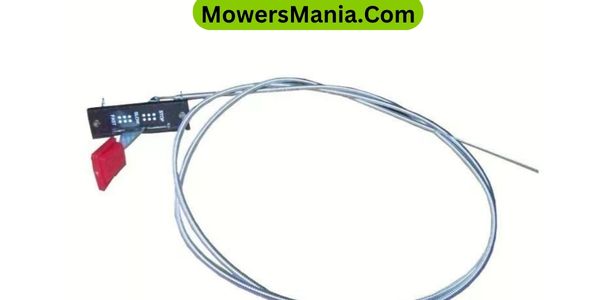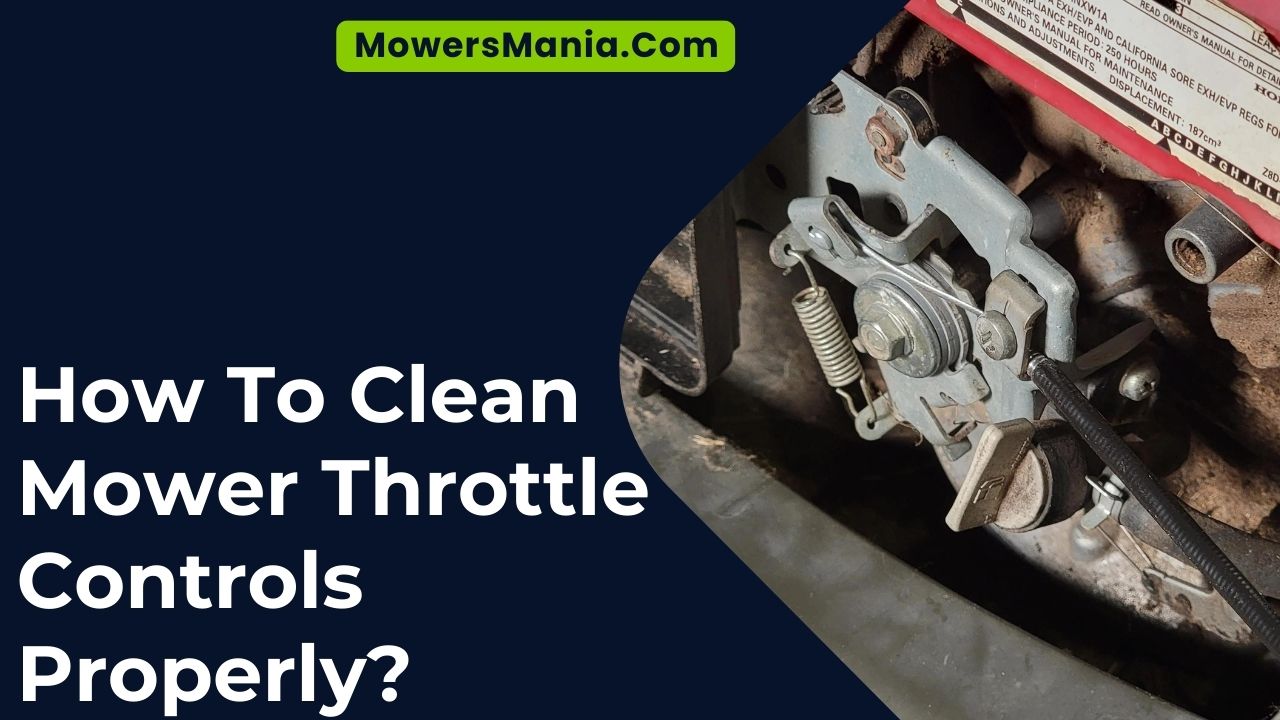When your mower’s throttle control becomes stiff and unresponsive, it can hinder your ability to efficiently mow your lawn. Properly cleaning the throttle controls is essential to ensure smooth and precise operation.
By following a few simple steps, you can restore the functionality of your mower’s throttle controls and improve its overall performance.

Understanding Mower Throttle Controls
To understand mower throttle controls, you need to know how they regulate the engine speed and power output. The throttle controls on a mower are vital for managing the engine’s performance.
When you push the throttle lever forward, it opens the throttle valve, allowing more air to enter the engine. This increase in air intake causes the engine to speed up, resulting in higher power output to the mower blades.
Conversely, pulling the throttle lever back restricts the airflow, reducing the engine speed and power. By adjusting the throttle controls, you can effectively manage the engine’s performance to suit different mowing conditions.
It’s essential to familiarize yourself with the throttle controls on your specific mower model, as they may vary in design and operation.
Understanding how the throttle controls impact the engine speed and power output will enable you to efficiently manage your mower’s performance while ensuring optimal cutting results.
Keep in mind that proper maintenance and periodic cleaning of the throttle controls are crucial to ensure their smooth operation and longevity.
Tools and Materials Needed
Gather the tools and materials necessary for cleaning the mower throttle controls to ensure a smooth and efficient process.
You’ll need a screwdriver, a clean cloth, a small brush (such as an old toothbrush), a can of compressed air, a can of throttle body cleaner, and a pair of gloves to protect your hands from any dirt or chemicals.
The screwdriver will be used to remove any screws or fasteners holding the throttle controls in place. The clean cloth and small brush will help you wipe away any visible dirt, grime, or debris from the controls.
The can of compressed air will allow you to blow out any hard-to-reach dirt or dust particles that may be lodged in the crevices of the controls.
Additionally, the throttle body cleaner will help to dissolve any built-up residue on the controls, restoring them to a clean and smooth operation.
Make sure to use the cleaner in a well-ventilated area and wear gloves to protect your skin from direct contact with the chemicals.
Removing Debris and Buildup

To begin removing debris and buildup from the mower throttle controls, inspect the control surfaces for any accumulated dirt or grease. Use a soft brush or cloth to gently wipe away the loose debris from the control levers, knobs, and linkages.
Pay close attention to areas where dirt and grime tend to accumulate, such as around the throttle linkage and at the base of the control levers.
For stubborn buildup, dampen a cloth with a mild detergent solution and carefully clean the affected areas, ensuring not to saturate the controls with excess liquid. Avoid using harsh chemicals or excessive water, as these can damage the control surfaces and internal components.
Next, use a small brush, such as an old toothbrush, to reach into tight spaces and dislodge any trapped debris. Be thorough but gentle to avoid causing any damage to the delicate components.
After removing the visible debris, use a dry cloth to wipe down the control surfaces and ensure they’re completely clean and dry before operating the mower. Regularly inspecting and cleaning the throttle controls will help maintain their functionality and extend their lifespan.
Lubricating Moving Parts
First, remember that proper lubrication of moving parts is crucial for the smooth operation of your mower’s throttle controls.
You’ll want to use the right type of lubricant for different components, such as silicone-based lubricants for plastic parts and lithium-based grease for metal components.
Additionally, make sure to follow the manufacturer’s recommendations for lubrication frequency to keep your mower in top condition.
Importance of Lubrication
Ensure that you regularly lubricate the moving parts of your mower throttle controls to maintain smooth operation and prevent premature wear.
Proper lubrication is essential for reducing friction between the components, which helps to extend the lifespan of your mower’s throttle controls.
Without adequate lubrication, the moving parts can become stiff and prone to seizing up, leading to operational issues and potential damage.
By keeping the moving parts well-lubricated, you ensure that they can move freely and smoothly, allowing the throttle controls to function as intended.
Additionally, lubrication helps to protect the metal parts from corrosion and rust, especially in outdoor environments where mowers are often used.
Regular maintenance and lubrication of the moving parts will contribute to the overall performance and longevity of your mower’s throttle controls.
Types of Lubricants
You should lubricate the moving parts of your mower throttle controls with the appropriate type of lubricant to ensure smooth operation and prevent premature wear.
When choosing a lubricant for your mower throttle controls, consider using:
- Silicone lubricant: Ideal for plastic and rubber parts, it provides smooth and long-lasting lubrication.
- White lithium grease: Perfect for metal-to-metal applications, it offers excellent protection against rust and corrosion.
- Graphite powder: Suitable for dry lubrication of components, it reduces friction without attracting dirt and debris.
- Teflon-based lubricant: Well-suited for high-temperature applications, it provides a slippery coating that reduces friction and wear.
Using the right lubricant will help maintain the functionality of your mower throttle controls and extend their lifespan.
Lubrication Frequency
To maintain the optimal performance of your mower throttle controls, it is essential to establish a regular schedule for lubricating the moving parts with the appropriate type of lubricant as discussed in the previous subtopic.
Proper lubrication reduces friction, wear, and tear on the moving components, ensuring smooth operation and longevity of the throttle controls.
Refer to the table below for a general guideline on the frequency of lubricating common moving parts in mower throttle controls.
| Moving Part | Lubrication Frequency |
|---|---|
| Throttle cable | Every 25 hours of use |
| Pivot points | Every 50 hours of use |
| Linkages and joints | Every 50 hours of use |
| Springs | Every 25 hours of use |
| Control levers | Every 50 hours of use |
Reassembling the Throttle Controls
After thoroughly cleaning each component, begin reassembling the throttle controls by carefully aligning the parts in the correct order. This process ensures that the controls function smoothly and effectively.
Follow these steps to reassemble the throttle controls properly:
- Positioning the Throttle Lever: Start by positioning the throttle lever in the correct location on the handlebar. Ensure that it’s securely in place before proceeding to the next step.
- Attaching the Control Cable: Attach the control cable to the throttle lever, making sure it’s properly secured and aligned according to the manufacturer’s specifications.
- Connecting the Cable to the Engine: Connect the other end of the control cable to the engine, ensuring that it’s correctly attached and adjusted to provide the appropriate tension.
- Testing the Controls: Once reassembled, test the throttle controls to ensure they move smoothly and adjust the engine speed accurately. Make any necessary adjustments before regular use.
Following these steps will help you reassemble the throttle controls correctly, ensuring optimal performance and longevity for your mower.
Testing and Fine-Tuning

Once the throttle controls are reassembled, thoroughly test and fine-tune their performance to ensure smooth and accurate engine speed adjustments.
Start the testing process by slowly moving the throttle lever from idle to full speed while the engine is running. Observe the engine’s response to ensure the throttle control is adjusting the engine speed smoothly and accurately.
If you notice any hesitation or irregularities in the engine’s response, further adjustments may be necessary. Fine-tune the throttle controls by making small adjustments to the throttle cable or linkage as needed.
Ensure that the throttle cable has the proper amount of tension to eliminate any slack but still allows for smooth movement. Additionally, check for any binding or sticking in the throttle linkage that could impede its proper function.
Once adjustments are made, repeat the testing process to confirm that the throttle controls are operating smoothly and effectively.
Properly testing and fine-tuning the throttle controls will ensure optimal engine performance and responsiveness during operation.
Frequently Asked Questions [FAQs]
Can I Use a Pressure Washer to Clean My Mower Throttle Controls?
You shouldn’t use a pressure washer to clean mower throttle controls, as it can cause damage. Instead, use a soft brush and soapy water to gently clean the controls, being careful not to saturate them.
How Often Should I Clean and Lubricate My Mower Throttle Controls?
You should clean and lubricate your mower throttle controls at least once a season to keep them working smoothly. Use a dry cloth and a silicone-based lubricant to remove debris and prevent rust.
Is It Necessary to Disconnect the Battery Before Cleaning the Throttle Controls?
You should always disconnect the battery before cleaning the throttle controls. This helps prevent any accidental starting of the mower and ensures your safety. It’s an important step in the cleaning process.
Can I Use WD-40 as a Lubricant for the Moving Parts of the Throttle Controls?
Yes, you can use WD-40 as a lubricant for the moving parts of the throttle controls. It can help to prevent rust and corrosion, ensuring smooth operation. Just be sure to apply it sparingly.
What Should I Do if the Throttle Controls Are Still Sticky or Not Functioning Properly After Cleaning and Lubricating?
If the throttle controls are still sticky or not functioning properly after cleaning and lubricating, you should check for any residual dirt or debris. Use a small brush or compressed air to clean thoroughly. If issues persist, professional assessment may be necessary.
Conclusion
Now that you’ve cleaned your mower throttle controls properly, your mower should run smoothly and efficiently.
Regular maintenance of your throttle controls will ensure that they continue to function properly and extend the life of your mower.
Keep an eye on any signs of wear and tear, and address any issues promptly to keep your mower in top condition.
Happy mowing!



